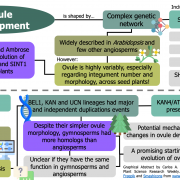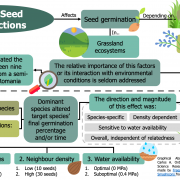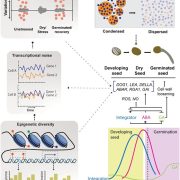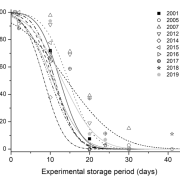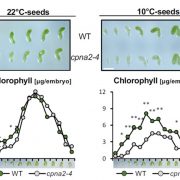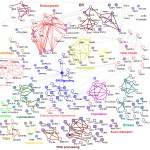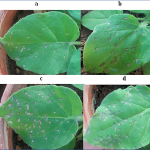Does fire drive fatty acid composition in seed coats of physically dormant species?
 Physical dormancy is imposed by an impermeable seed coat that prevents water uptake. For germination to occur, this coat must be broken. Fire passage, for example, breaks physical dormancy in ecosystems where such events are recurrent. However, the mechanisms behind how fire achieves this has yet to be explored. Fatty acids (FAs) influence seed coat permeability, so they are a promising starting point for elucidating the chemical mechanism behind physical dormancy break. In this pioneering paper, McInnes and colleagues assess the FAs composition of seeds from 25 Fabaceae from fire-prone and fire-free Australian ecosystems. Species from fire-prone ecosystems had seeds with relatively more FAs than those from fire-free sites. Notably, these species had larger FAs and relatively more unsaturated ones. Large, unsaturated FAs increase seed coat impermeability and have higher melting points that match the temperatures required for the germination of species from fire-prone ecosystems. This research ignites a new, fascinating research area that will contribute to a better understanding of the germination of physically dormant seeds. (Summary by Carlos A. Ordóñez-Parra @caordonezparra) Plant Biol. 10.1111/plb.13498
Physical dormancy is imposed by an impermeable seed coat that prevents water uptake. For germination to occur, this coat must be broken. Fire passage, for example, breaks physical dormancy in ecosystems where such events are recurrent. However, the mechanisms behind how fire achieves this has yet to be explored. Fatty acids (FAs) influence seed coat permeability, so they are a promising starting point for elucidating the chemical mechanism behind physical dormancy break. In this pioneering paper, McInnes and colleagues assess the FAs composition of seeds from 25 Fabaceae from fire-prone and fire-free Australian ecosystems. Species from fire-prone ecosystems had seeds with relatively more FAs than those from fire-free sites. Notably, these species had larger FAs and relatively more unsaturated ones. Large, unsaturated FAs increase seed coat impermeability and have higher melting points that match the temperatures required for the germination of species from fire-prone ecosystems. This research ignites a new, fascinating research area that will contribute to a better understanding of the germination of physically dormant seeds. (Summary by Carlos A. Ordóñez-Parra @caordonezparra) Plant Biol. 10.1111/plb.13498


